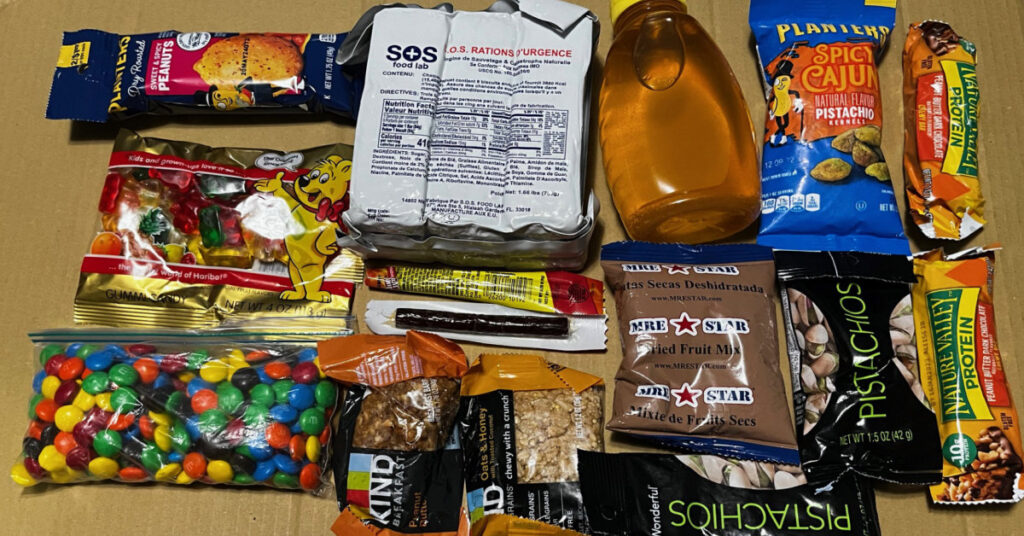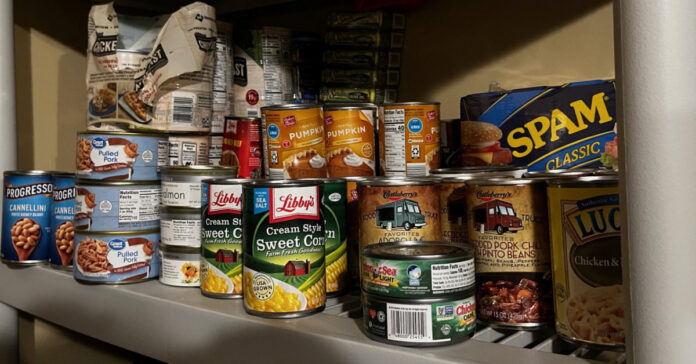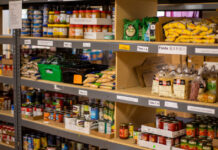Last week, I swung by Walmart to pick up something. While I was there, I added ten canned goods to my stockpile.
First, I purchased six cans of cannellini beans, which my wife uses in cooking, for 82 cents each. We usually start with 12 on hand and then when we use some up, we re-stock, so this was a restocking purchase. I will grant you we could buy dried white northern beans, which are the same thing, for less, but they are not as convenient to use because they would need to soak for hours or even overnight before cooking. We do have #10 cans of these beans in our long-term storage.
Second, I purchased three cans of Castleberry’s Food Truck chili that is made with shredded pork instead of beef. We have lots of beef chili in hand, so I like to add chicken and pork chili from time to time to give us some variety. When I got home, one can was dented from rolling around in the car, so I will have to eat that one soon.
I also bought a small canned ham and a bag of chocolates. Chocolate is one thing I missed during the COVID lockdown, and with the price rising, I figured I would beat the rush.
That’s ten canned goods for less than $20. Not bad for a top-off purchase.
Meals, Ready to Eat
Last week, I ate two of the older MRE entrees from our stash in an effort to rotate them out. They were fine, and I suffered no ill effects, but the tortellini wasn’t very tasty. The pasta was soggy and the red sauce was unappetizing. Given the choice, I’d rather eat a can of Chef Boyardee mini ravioli or beefaroni.
I’ve seen people on YouTube who make homemade MREs using items purchased at the dollar store or Walmart. They usually contain meat or an entrée in a retort pouch, a couple of protein or breakfast bars, a pack of cookies or crackers, a drink mix, and maybe a pouch of nuts or dried fruit stuffed in a Ziploc bag. While you are unlikely to achieve the five-year shelf life of an MRE made by a military contractor, these can be a cost-saving option. I could see having several in your bugout bag or vehicle emergency kit.
One plus of the make-your-own MRE is that you can make whatever menu plan you want. If you want a pouch of tuna, your kids want a pouch with two slices of SPAM, and your spouse wants a pouch of pork in barbecue sauce, there’s nothing stopping you from configuring the MREs. The downside is that for a family of three or four, buying individual pouches or packs of foods is more expensive than buying a can of Spam or two cans of tuna. To put this in perspective, one 12-ounce can of Great Value pulled pork is $4.12 while a 2.6-ounce pouch is $1.50, close to twice as much per ounce. Keep your budget in mind when stocking your bugout bags.
Lightweight Foods for Bugging Out
Whether you are making your own MREs or just packing your bugout bag, avoid the canned goods and look for lighter products if you expect to be carrying your food supply on your back. We pack our canned goods in cardboard boxes for transport by vehicle.
I am not a big fan of storing freeze-dried foods because they are expensive and take up more room than dried or dehydrated foods. However, their lighter weight makes them ideal for bug out bags. Traditional MREs are heavy, while a pouch of freeze-dried food is light. As long as you can find water, you can rehydrate your pouch and eat it. MREs don’t need to be rehydrated, which is why they are heavier.
Pasta is also lightweight, as is oatmeal. Powdered soups are another option that won’t weigh you down. Again, they all need water. Be sure to have a water filter.
Drink mixes are worth having for two reasons: First, if you avoid the calorie-free ones, the sugary drink will give you a boost of carbs. Second, the drink mixes will cover up the taste left behind by water purification tablets, making the water more palatable. I carry packets of Gatorade drink mix because it will also replenish our electrolytes.
Calories Count
If you are bugging out in your vehicle, then you won’t be burning too many extra calories. If you have to hoof it for long, especially carrying a pack and a gun, you will find it is difficult to carry enough food. In fact, most serious backpackers find themselves in a calorie deficit rather quickly and have to resupply every few days. Unless you have caches along the way, you won’t have that option.

Assuming you are healthy, your body will adapt to the lack of food and you may go into ketosis, similar to what people on the Ketogenic Diet experience. If you have never put yourself into this state before, expect it to suck for the first few days. If you have been in ketosis or have experience going without sufficient food, you will probably adapt much quicker. Keep in mind that there is a difference between being hungry and starving. Starvation shouldn’t set in until a couple of weeks without food, but you may find yourself weak or have muddled thoughts.
Although we plan to bug in, I expect we will all lose weight in a long-term grid-down scenario. Even if I have plenty of food in my stockpile, we’ll be on limited diets to help stretch our supplies. I expect there will be times of surplus when we can eat our fill—like when the garden produces more than we can consume or preserve or we kill an animal and there is no refrigeration. There will likely be more times when we are not raising, gathering, or hunting sufficient food to fill our bellies. Like our caveman and hunter-gatherer ancestors, our bodies can deal with this. The question is whether our modern minds can. If you’ve never been hungry, it’s going to be an adjustment.
Eat when you Can
They say an experienced soldier sleeps when he can, taking advantage of every opportunity to get some shuteye because they never know when they will have to stay up and function for hours at a time. I’d say an experienced prepper eats when there is food. Let your body put on fat when the berries or fruit are ripe or when you make a kill. Then you can burn it off when the fields are brown and the chickens are barely laying because of the short days.
Don’t consider this an excuse to fatten up now. Instead, use this as your chance to put on muscle.
If you expect to bug out by foot, you should ruck or go on recreational hikes and overnight trips for practice. Besides strengthening your body, it will help you optimize your equipment. Better to learn valuable lessons now than during a disaster. For example, you might find a Mountain House pouch doesn’t really feed two and your tent is too heavy. If your pack is heavy, a few days in the field will tell you what you can leave out and what you never want to be without.
Stock up and practice your survival skills. We never know what awaits us down the road.







